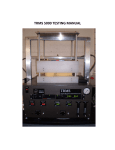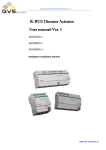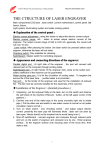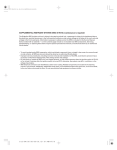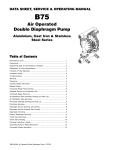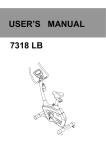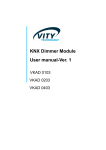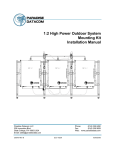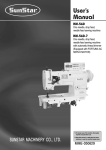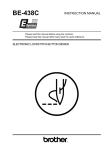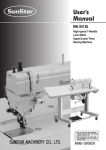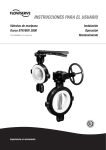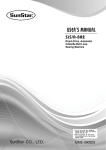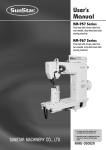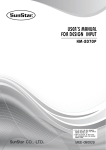Download USER`S MANUAL
Transcript
USER ’ S MANUAL SBF-20 Automatic Button Feeder 1) FOR AT MOST USE WITH EASINESS, PLEASE CERTAINLY READ THIS MANUAL BEFORE STARTING USE. 2) KEEP THIS MANUAL IN SAFE PLACE FOR REFERENCE WHEN THE MACHINE BREAKS DOWN. SUNSTAR MACHINERY CO., LTD. MME-051219 USER’S MANUAL SBF-20 Automatic Button Feeder lity a u tQ Besst Pricevice Be st Ser Be 1. Thank you for purchasing our product. Based on the rich expertise and experience accumulated in industrial sewing machine production, SUNSTAR will manufacture industrial sewing machines, which deliver more diverse functions, high performance, powerful operation, enhanced durability, and more sophisticated design to meet a number of user’s needs. 2. Please read this user’s manual thoroughly before using the machine. Make sure to properly use the machine to enjoy its full performance. 3. The specifications of the machine are subject to change, aimed to enhance product performance, without prior notice. 4. This product is designed, manufactured, and sold as an industrial sewing machine. It should not be used for other than industrial purpose. R SUNSTAR MACHINERY CO., LTD. 1. Machine safety regulations ---------------------- 6 2. M/C structure & specifications ----------------- 8 1) 2) 3) 4) 5) Basic parts and option parts ----------------------Machine structure ------------------------------------Machine specifications ------------------------------Control box specifications --------------------------Control box inner structure ------------------------- 8 9 9 10 11 9. Button change ------------------------------------ 41 1) 2) 3) 4) 5) 6) Changing feeding pin -------------------------------Changing button clamp -----------------------------Chute adjustment ------------------------------------Buttons that are not allowed to use -------------Using buttons whose diameter is less than 10mm --Button selector ---------------------------------------- 41 42 43 44 44 45 10. Operation ----------------------------------------- 47 3. Installation ------------------------------------------ 12 1) 2) 3) 4) 5) 6) 7) Table ---------------------------------------------------Button sewer & button feeder ---------------------Button bowl -------------------------------------------Air wiper ----------------------------------------------Filter regulator ----------------------------------------Connecting air tube ---------------------------------Exchanging button clamp --------------------------- 12 13 17 20 21 22 24 1) Building the button column ------------------------- 47 11. Maintenance -------------------------------------- 48 1) 2) 3) 4) 5) 6) Changing spinning rubber --------------------------Changing chute motor ------------------------------Replacing chute belt & chute bearing -----------Control button thickness ----------------------------Control button clamp sensor ----------------------Adjusting the button revolving base return spring --- 48 48 49 53 53 54 4. Power voltage ------------------------------------- 25 1) Power voltage specifications ------------------------ 25 12. Troubleshooting ---------------------------------- 55 5. Changes according to frequency -------------- 26 13. Other ---------------------------------------------- 57 1) Motor specification change according to frequencies - 26 2) Installation of vibration connector according to frequencies --- 27 1) Initializing the machine ------------------------------- 57 2) Parameter setting ------------------------------------- 58 3) Parameter setting method --------------------------- 59 6. Connection of control box cables ------------- 28 1) Connections inside the control box --------------- 28 2) Connections outside the control box -------------- 29 14. Error signs and troubleshooting -------------- 61 15. Machine test function -------------------------- 62 7. Program unit panel method of use ----------- 30 1) Names of parts --------------------------------------2) Initial screen ------------------------------------------3) Key functions -----------------------------------------3-1) Displayer keys --------------------------3-2) Transfer time adjusting key -----------3-3) Main function keys ---------------------- 30 31 32 32 33 34 1) 2) 3) 4) 5) Motor test function (t-01) ---------------------------Solenoid test function (t-02) ------------------------Thread trimming cam sensor test function (t-03) --Cam sensor test function (t-04) -------------------Reset switch test function (t-05) ------------------- 63 64 65 66 67 8. Test ------------------------------------------------- 39 1) By air valve -------------------------------------------- 39 2) By hand ------------------------------------------------ 40 5 1 Machine Safety Regulations The safety signs in this manual are DANGER, WARNING and CAUTION. If you do not follow these instructions, it may cause physical damage or machine breakdown. DANGER : This sign should be observed carefully. If the instructions are not followed, it may cause harm during the installation, conveyance and maintenance of the machine. : WARNING If you follow the instructions under this sign, you will prevent harmful effects. CAUTION : If you follow the instructions under this sign, you will prevent errors from happening. 1-1) Machine Conveyance Only experienced workers fully aware of the safety guide should carry the machine. When carrying the machine, follow the following instructions. At least 2 people should carry the machine. To prevent accidents when carrying the machine, please clean all oil stains found in the machine. DANGER 1-2) Machine Installation WARNING 1-3) Machine Reparation CAUTION 6 When installing the machine, physical damage such as machine malfunction or breakdown may occur due to the machine's surrounding. Therefore, please satisfy the following conditions. When unpacking the machine, start in order from the top. Because dust and humidity contaminate or cause the machine to erode easily, install a dehumidifier or air cleaner and clean the machine frequently. Keep the machine away from direct sunlight. Leave 50 cm of space between the machine and the wall on the right, left and back of the machine to have sufficient repairing space. Danger of explosion Do not operate the machine in an environment inducive of explosives. If the machine operation has no special guarantee, do not operate the machine on hazardous places including those that use aerosol spray cans or places that have oxygen-related products in order to avoid explosions. This machine does not include lighting devices. You must supply and install your own lighting equipment for your work area. When the machine needs repair, a trained A/S technician from the company must carry out the repairing job. Before cleaning or repairing the machine, make sure to stop all machine operations and wait 5 minutes until the machine becomes completely discharged. You must not change any of the contents or specifications of the machine without previously consulting with a SunStar company worker. These changes can threaten safe machine operations. When repairing the machine, make sure to use genuine parts from our company. After repair, make sure to put back all the safety covers that were removed during repair. R 1-4) Machine Operation WARNING The SBF-20 is a button feeder made for industrial purposes. Make sure to follow the instructions below when operating the machine. Read this manual thoroughly and understand it exhaustively before operating the machine. Wear appropriate clothes for work safety. Do not put your hand or any part of your body near any machine part that moves (button feeding pin) while the machine is operating. Do not remove any safety plates or any type of cover while the machine is operating. Make sure to connect all ground conductors. Shut off all electric operations and make sure that the power is “OFF” before opening the control box. If possible, install all strong electric wave sources such as high frequency welders, etc. away from the machine. [ Warning ] Your hand or finger can be cut or injured due to the button feeding pin, so never put your hand or any body part near the machine while the machine is operating. 1-5) Location of Caution Signs WARNING HIGH VOLTAGE MAY CAUSE INJURY. TURN OFF THE MAIN SWITCH AND DISCONNECT THE POWER PLUG BEFORE OPENING THE COVER. 7 2 M/C Structure & Specifications 1) Basic Parts and Option Parts A. Button Sewer / Button Feeder Set Basic Parts and Accessory of Button Sewer Feeder and Button Bowl Filter Regulator and Accessory Table (Ass y) B. Basic Parts of Button Feeder Feeder and Button Bowl Button Clamp(Ass y) Filter Regulator and Accessory C. Option Parts of Button Feeder Pedal(Ass y) Pedal for exclusive use of Sunstar s button sewer Table No. Name Explanation 1 Table A For Sunstar’s belt-type button sewer (SPS/A-B1202) 2 Table B For Sunstar’s direct drive motor button sewer (SPS/B-B1202) 3 Table C For JUKI’s chain-stitch type M/C(MB-373, 372) 4 Table D For JUKI’s lock-stitch type M/C(LK-1903) 5 Table E For Brother’s chain-stitch type M/C(CB3-B916, B917) 6 Table F For Brother’s lock-stitch type M/C(BE-438C) Note Feeder Base No. Name Explanation 1 Base A For JUKI’s chain-stitch type M/C (MB-373, 372) 2 Base B For JUKI’s lock-stitch type M/C (LK-1903) 3 Base C For Brother’s chain-stitch type M/C (CB3-B916, B917) 4 Base D For Brother’s lock-stitch type M/C(BE-438C) Spinning Rubber Guide(S) Part that ONLY used for the button whose diameter is less than 10mm 8 Note R 2) Machine Structure Button Sewing M/C Button Feeder Button Clamp Operation Box Operation Box for Button Sewing M/C Button Bowl Power Switch Filter Regulator Pedal Switch 3) Machine Specifications Feeding and Sorting of Buttons By Vibrator Button Feed Mode Automatic / Semi-Auto / Manual Mode Button Size Control Automatic Control Mechanism by a Sample Button Button Feed Mode Horizontal Feeding System Compressed Air 0.49MPa (5.0 kgf/ ) 9 4) Control Box Specifications Motor Specifications Item SBF-20 Power voltage Single phase 220V Frequency 50Hz , 60Hz Main motor S8I25GXCE Chute motor (Button feed motor) Left, right rotating motor (Button hold motor) S6IO6GXCE Vibrator Temperature 10 50Hz 60Hz Gear S8DA9B-K52 S8DA10B-L02 Head 50Hz 60Hz M41A3G2Y S6DA15B-K67 TS05-0061 50Hz , 60Hz 5 ~ 40 Humidity 20% ~ 80% Fuse 250V , 2A Time to supply the buttons after sewing Max : 244[ms] (Out of the factory: 24[ms]) Time to rotate left and right rubber Max : 1.93[s] (Out of the factory: 760[ms]) Time for sewing twice Max : 1.94[s] (Out of the factory: 380[ms]) Chute closing time Max : 464[ms] (Out of the factory: 220[ms]) R 5) Control Box Inner Structure Power Switch AC Filter Buzzer CPU Transformer (24V/8.5V) 11 3 Installation 1) Table A. Driven by belt (SPS/A-Series) B. Direct Drive Type (SPS/B-Series) 12 R 2) Button Sewer & Button Feeder When you install a feeder after an additional procurement together with Sunstar’s button sewer, please exchange the button clamp in the button sewer which is provided with the button feeder referring to the corresponding the page 24 of it. A. Fix the oil tube holder①, oil holder ②, control box③, power switch ④, and setting base⑤ on the table. [ Fig. 1 ] B. Attatch the bed cushion rubber to the setting base. Cushion Rubber [ Fig. 2 ] C. Add the hinge metal and hinge rubber to the bed. Then insert the fixing bolt into the hinge metal hole of point ① and fix the table as shown in the [Fig.3]. Fixing Bolt Hinge Rubber Hinge [ Fig. 3 ] [ Danger ] The machine should be carried by more 2 people for safety. 13 D. Stand the machine as shown in the [Fig. 4], and then fix the machine on the table after inserting the fixing blots into the hinge metal holes of point ①. [ Fig. 4 ] E. Screw the bed fixing bolt on the back of the table as drawing [Fig. 5]. [ Fig. 5 ] [ Danger ] Since the machine is not perfectly installed on the table, extreme care is needed when you make the machine stand up not to have any accident occurred. F. Please kindly refer to Page 20 in the manual of the button sewer concerning the connection of the button sewer connector and the installation of other parts. G. Temporary fix the 4 fixing bolt ① on the table after you properly put button sewer on the table. [ Fig. 6 ] H. Start setting the button sewer and the feeder. Power on the button sewer and adjust the operation box by using the provided basic pattern no. 1 after inserting the button clamp no. 2 and the transfer plate no. 3 in the feeder. And correct the left backward pin among the 4 ones and the center of needle exactly as shown in [Fig. 7] when it stops at the center of the button clamp for a while by operating the feeding pin manually during the power on.(please, refer to Page 40). Fix the feeder on the table tightly by fastening 4 EAs of the fixing screw after the setting. Correcting the center with the needle [ Fig. 7 ] [ Danger ] Please progress on by making sure the changed status of the setting when fastening the fixing screws. 14 R I. After finishing previous pages, as drawing [Fig. 8], loosen ①, ② of button sewer and adjust to make gap 0.5mm bewteen feeding pin① and button clamp② as drawing [Fig. 9]. Tighten again after correctly setting. [ Fig. 8 ] 3 1~2 0.5 [ Fig. 9 ] [ Fig. 11 ] [ Fig. 10 ] Drawing [Fig. 12], revolve the handle, loosen ① bolt and adjust ② to make gap 2㎜ between ① and ② when the feeding pin starts coming back from above needle plate as drawing [Fig. 11]. Button clamp will break needle if you adjust ② too high. [ Fig. 12 ] 15 J. Attach the adjacent ① which monitors whether the button sewing machine is functioning thread trimmer in the inner part of Arm. At that time, fix the sensor (Set ① & ②) by using the screw ③. ① ② ③ [ Fig. 13 ] Adjust the position of sensor to correct the distance from the end terminal of the sensor ① to the thread loosening pin ④ to be about 1mm. [ Fig. 14 ] 16 R 3) Button Bowl [ Fig. 15 ] A. Put in fixing screw after laying the table ring on the table. [ Fig. 16 ] B. Temporary fix the nut ① to attach the table ring and table. ① [ Fig. 17 ] 17 C. Temporary fix the fixing nuts ①, ② after assemble vibrator base at the fixing screw. [ Fig. 18 ] D. Strongly tighten fixing nut ① of the [Fig.17] after correctly put the vibrator on rubber base. Press once to rubbers go into the hole. (Electric wire has to be toward button supplier) [ Fig. 19 ] E. Temporary fix the fixing screw ① after put button feeder on vibrator. [ Fig. 20 ] 18 R F. Loosen fixing nuts ①, ② as in [Fig.18]. Use the setting gauge① to adjust the chute belt (A) in [Fig.21] and the height of feeder entrance (B) to be distant from each other by 1mm, and tighten the fixing nuts. Loosen the fixing screw ① as in [Fig.20] and use the setting gauge ② to make the chute’s right side (C) distant from the button feeder’s right side (D) by 2mm and then tighten the screw. If the distance is incorrect, make the adjustment by using the nuts ①, ② as in [Fig.18] . 1mm Setting gauge 2mm 2mm C D 1mm A B [ Fig. 21 ] G. Lock the handle ① in drawing [Fig. 22] after setting vibrator and button bowl. And connect vibrator jack and feeder jack as drawing [Fig. 23]. [ Fig. 22 ] [ Fig. 23 ] H. Strongly tighten the bolt ① in drawing [Fig. 24] after all setting. (It is very important to vibration.) ① [ Fig. 24 ] 19 4) Air Wiper [ Fig. 25 ] A. Please fix the wiper bracket A in the button sewer body by using the fixing screw ① as shown in [Fig. 26]. ① A [ Fig. 26 ] B. Adjust the air wiper ① to prevent that thread out from needle. ① [ Fig. 27 ] 20 R 5) Filter Regulator Don’t put oil in Air filter A Gauge pressure has to be 0.5MPa(5㎏f/㎠). (Caution : Minimum 4㎏f/㎠~maximum 6㎏f/㎠. The machin go wrong under airpressure 4㎏f/㎠.) Hold up to turn ①. Air pressure will be up if you turn it left. Air pressure will be down of you turn it right. Please press a handel after adjusting airpressure. Loosen ② to remove the water in A after long time works. The cylinder will be wrong if water exist in A. 21 6) Connecting Air Tube Air Wiper Button Clamp Cylinder Clutch Cylinder Chute Cylinder Chute Air Blower 22 Filter Regulater R Air System Circuit Diagram 23 7) Exchanging Button Clamp Among the users of‘SPS/A-B1202’and‘SPS/B-B1202’, if you want to use‘SBF-20’additionally, you shall exchange the existing button clamp into an exclusive button clamp. A. Separate the tension adjusting screw (Set) ①. Take out the button clamp holder shaft③ by unfastening the fixing screw (2EA)②. [ Fig. 28 ] B. Separate the button clamp (Set) ④ as shown in [Fig. 28]. [ Fig. 29 ] C. After mounting the exclusive button clamp ①, fix the button clamp ① by using the button clamp holder ② and the fixing screw (1EA) ③. Finally attach the tension adjusting screw (Set) ④. ④ ① ① ②③ [ Fig. 30 ] 24 R 4 Power Voltage 1) Power Voltage Specifications A. Exclusive use for single phase 220V B. Changing the power voltage Change the power voltage by using a transformer Transformer model being used: SBF-20-220 If the transformer model being used is incorrect, you may damage the control box. Always use the instructed model. CAUTION 25 5 Changes According to Frequency You may use both the 50Hz and 60Hz frequencies for the model SBF-20. The specifications for the motor and vibrator change according to these two interchangeable frequencies. 1) Motor Specification Change According to Frequencies Category Model Gear Head 50Hz 60Hz S8I25GXCE Chute Motor (Button Feed Motor) S6IO6GXCE The left and right rotating motor (button holding motor) does not use a gear head. If the gear head specifications according to frequencies do not match, the button feeding operation may not operate smoothly. CAUTION 26 R 2) Installation of Vibration Connector According to Frequencies buzzer CPU 27 6 Connection of Control Box Cables 1) Connections Inside the Control Box Power Switch Power Switch Connecting Cable AC-Filter Input Cable AC Filter Transformer Input Cable AC-Filter Output Cable Transformer Output Cable Buzzer CPU Transformer (24V/8.5V) Vibrator Intensity Adjusting Cable Vibration Adjusting Device 28 Program Unit Cable R 2) Connections Outside the Control Box Cooling Fan Cable Solenoid Output Cable Thread Trimming Cam Connecting Cable Reset Switch Connecting Cable Power Switch Cam Sensor Connecting Cable Right, Left Rotating Motor Connecting Cable Main Motor Connecting Cable Chute Motor Connecting Cable Power Cable Vibrator Output Cable Buzzer Transformer (24V/8.5V) Vibration Adjusting Device 29 7 Program Unit Panel Method of Use 1) Names of Parts Main motor ON/OFF Key Auto / Semi-Auto Mode Key Double / Single Mode Key Chute Motor ON/OFF Key Chute Motor Clockwise / Counterclockwise Rotation Mode Key Vibrator ON/OFF Key Displayer Screen + Key – Key Clear Key Displayer Screen of 'Transfer Time' Value Up Key Down Key Parameter Key Vibrator Adjusting Device Light 30 R 2) Initial Screen When you turn the power on, you will see the last programmed work of the button feeder. (Example) On the figure above, the programmed work of the button feeder before the power was turned on is as follows: Button feeding mode : SEL 1 Work amount : 123 Chosen value for transfer time : 0 Main motor was operating Auto mode was selected Single mode was selected Chute motor was operating Chute motor was rotating clockwise Vibrator was operating 31 3) Key Functions 3-1) Displayer Keys Displayer Keys When buttons are fed after sewing work is completed, the number in the displayer will automatically increase by +1. If the buttons are fed, the number on the displayer will automatically increase by +1. The numbers “0” to “9999” will appear on the screen. After “9999”, the number “0” will appear again. Screen showing work amount Everytime this key is pressed, the number in the displayer will increase by +1. (If you continue to press this key, the number will increase automatically.) Key Everytime this key is pressed, the number on the displayer will decrease by –1. (If you continue to press this key, the number will decrease automatically.) Key Reset the number appearing on the displayer to “0”. Key 32 R 3-2) Transfer Time Adjusting Key Transfer Time Adjusting Key This key controls the time the button feeder starts feeding buttons after sewing work is completed. On this screen you will see the numbers “0” to “9”. After “9”, number “0” will appear again. Value of transfer time Everytime this key is pressed, the transfer time will increase by +1. (If you keep on pressing this key, the numbers will increase automatically.) Up Key Everytime this key is pressed, the transfer time will decrease by –1. (If you keep on pressing this key, the numbers will decrease automatically.) Down Key Number “0” signifies that the buttons will be fed at the fastest speed while number “9” signifies that the buttons will be fed at the slowest speed. 33 3-3) Main Function Keys Main Function Keys Main Motor's ON/OFF Key Everytime these keys are pressed, the main motor will turn on and off repeatedly. The displayer key and transfer time adjusting key operate independently from the main motor's on/off key. The main motor is operating. You can operate all the function keys of the button feeder. The main motor has stopped operating. All the functions of the button feeder have stopped. You can operate the parameter key functions. 34 R Auto/Semi-Auto Mode Key Everytime you press these buttons, the Auto or Semi-Auto modes are repeated. You can operate the functions of these keys when the main motor is operating. Buttons are fed automatically after sewing work is completed. The button feeder will not feed buttons until the sewing work is completed. When working with a lot of sewing materials, it use. Press the reset switch and the machine will feed one button at a time. RESET SWITCH 35 Double / Single Mode Key This key is used for button sewing or when you want to sew buttons twice as fast or faster than the basic sewing time. This key is used only for Chain Stitch button sewing machines. You can operate the functions of these keys when the main motor is operating. When using button sewing machines except chain stitch, select and use the single mode. This key is used for chain stitch button sewing machines only. Adjustment of sewing time can be done on parameter “A-01”. (Refer to the page on parameter setting.) 36 R Chute Motor ON/OFF Key This key turns ON/OFF the button feeding belt. You can operate the functions of these keys when the main motor is operating. Chute motor is operating. Chute motor has stopped. Chute Motor's Clockwise and Counterclockwise Rotation Mode Key You can operate the functions of these keys when the main motor is operating. You can operate this key when the chute motor is operating. The chute motor will rotate clockwise and the buttons can be fed through the button feeding pin. The chute motor will rotate counterclockwise and the buttons on the button feeding belt will be sent towards the direction of the vibration. 37 Vibration ON/OFF Key You can operate the functions of these keys when the main motor is operating. Refer to the page 27 on selection of connectors according to local frequency type. Vibration is operated and buttons are sent to the feeding belt. Vibration has stopped. Adjusting Vibration Intensity Vibration Adjusting Device If you turn the vibration adjusting dial to the right, the vibration becomes stronger. The user must adjust the intensity of the vibration according to the programmed work. 38 R 8 Test 1) By Air Valve [ Fig. A ] The button clamp opens by operating the button clamp cylinder when turn the valve handle ③ as shown in [Fig. A]. Please shut off the valve tightly after testing. Feeder’s clutch cylinder and chute cylinder will be simultaneously worked when you turn the valve handle ② as shown in [Fig. A]. After open valve, if you turn the right handle to the left, transfer pin will be moved, please close the valve after testing. The air exhausts from the blowers (2 positions) under the button transfer chute when turn the valve handle ① as shown in [Fig. A]. Please shut off the valve tightly after operating the valve. 39 2) By Hand ① Another method to move feeding pin : Disconnect air jack first, feeder’s clutch will be open if you put thin stick into a hole ① screw dirver such as drawing [Fig. A]. If you turn the handle as drawing [Fig. B], the feeding pin will be moved as drawing [Fig. C]. [ Fig. A ] [ Fig. B ] [ Fig. C ] 40 R 9 Button Change 1) Changing Feeding Pin Button No. 1 2 3 4 5 No. of hole Range fo Sewing(mm) Expansion & Reduction(%) 2 4 2 4 2 4 2 4 2 4 2.5 2.2 2.2 2.9 2.7 2.7 3.5 3.2 3.2 4 3.8 3.8 4.5 4.5 4.5 74% 65% 85% 79% 103% 94% 118% 112% 132% 132% Note Standard range 3.4( 3.4) [100%] [ Fig. 31 ] A. Put a button in button hole size check board which is suitable number of pin as drawing [Fig. 31]. For example, as drawing [Fig. 31] use feeding pin 4 hole No. 3 if the button hole is suit able for 4 hole No. 3. ① [ Fig. 32 ] B. After selecting the feeding pin, press ① part and loosen fixing screw ② to change transfer pin as shown in the [Fig. 32]. For example, as drawing [Fig. 31] use feeding pin 4 hole No. 3 if the button hole is suit able for 4 hole No. 3. (Regarding selection of feeding pin, please refer to the attached sticker in the machine.) Please establish a range of sewing (expansion and reduction) for the button sewing machine dependent on the interval between button holes by referring the above Table. Please establish 94% of the expansion and reduction for the 4 hole No. 3. 41 2) Changing Button Clamp A [ Fig. 33 ] A. Insert the buttons to be used into (A) as in [Fig. 33]. Depending on the colors pointed by the pin as in [Fig. 33], choose the number of the button clamp. For example, when the pin ① points at yellow, choose No. 2 button clamp (as for the choice of button clamps, see the sticker attached to the machine). B. Choose a button clamp as in [Fig. 33], and loosen and remove the fixing screw ① as in [Fig.34]. Insert and tighten the button clamp (for the choice of button clamps, see the sticker attached to the machine). [ Fig. 34 ] C. Replace the button clamp chosen in [Fig. 33] with reference to [Fig.34]. Then the button holes get automatically aligned with the center of the needles. Therefore do not loosen the fixing screws ①, ② as in [Fig.35] to make adjustment. [ Fig. 35 ] 42 R 3) Chute Adjustment This machine is suitable for the buttons whose external diameter is 10mm or above. If it is necessary to use buttons whose external diameter is less than 10mm (up to 8mm in external diameter), make additional purchase of optional parts as in page 8 for replacement. (O) Button [ Fig. A ] (X) [ Fig. B ] [ Fig. 36 ] A. Turn ① in the arrow direction. [ Fig. 37 ] B. Push ② backward and insert buttons. When inserting buttons, make sure that buttons are placed face-down as in [Fig. A]. If the buttons are placed in the opposite way as in [Fig. B], the buttons are not fed to the chute. [ Fig. 38 ] C. Insert buttons into ③ and move ① back to the original position. Then the buttons are sorted by size, thickness and they are aligned along with the center at the same time. ③ [ Fig. 39 ] 43 4) Buttons that Are Not Allowed to Use For the buttons whose shapes are the following, it shall not be allowed to work using ‘The specifications taking out of factory for SBF-20’. You shall place a purchase order with our company after a consultation with us when you are going to use the following buttons. No. Name Explanation Note 1 Paduk Button 2 Convex Button 3 Slope Button 4 Shell Button - Button that made of shell. 5 Symmetry Button - Shape of upper part and that of lower part are same. 5) Using Buttons whose Diameter Is Less than 10mm When you will use buttons whose outer diameter is less than 10mm, you shall exchange “spinning rubber guide” into “spinning rubber guide (splace) of the optional part” (referring to Page 8). Please exchange it referring to the following Fig. Spinning Rubber Guide (S) 44 R 6) Button Selector A. Put the button in feeder, loosen ① and adjust ② to make button pass one by one. Tighten ①. [ Fig. 40 ] B. When you use direction. If you lift up ④ shaped button, loosen ①, ② and turn ③ to the clockwise direction ④ rises. It move down if turn to opposite shaped button will be passed, shaped button will be fallen. A [ Fig. 41 ] C. B [ Fig. 42 ] shaped button : loosen ① and adjust ②, tighten ① again as shown in the [Fig. 43]. [ Note ] In this occasion the gap in drawing left has to be 2mm. (Continue next page drawing [Fig. 44]) 2mm [ Fig. 43 ] 45 D. As drawing [Fig. 44], loosen ① to adjust ② to make right side button pass and wrong side button falls down to A part, and then tighten ①. A [ Fig. 44 ] E. To select shaped button. After setting as drawing [Fig. 43], loosen ① to adjust ② that right side button pass, wrong side button falls down to A part, and then tighten ①. The sawtooth can select all kind of buttons which has a furrow. A [ Fig. 45 ] F. As drawing [Fig. 46], loosen ① to adjust ② to make the buttons go into the chute and tighten ① as drawing [Fig. 47]. [ Fig. 46 ] [ Fig. 47 ] 46 R 10 Operation 1) Building the Button Column Turn A in the right direction as in [Fig. 48] for the button column reeling. Loosen ① to adjust the height of ② and tighten ① again. If the button column reeling is unnecessary, turn A in the left direction as in [Fig. 49]. ① [ Fig. 48 ] [ Fig. 49] B 47 11 Maintenance 1) Changing Spinning Rubber ① [ Fig. 50 ] Lift up ① to change spinning rubber as drawing [Fig. 50]. 2) Changing Chute Motor [ Fig. 51 ] Loosen the fixing screws ① and ②. Loosen all the fixing screws, pull out the chute and change new chute motor. Tighten the fixing screws ①, ② after making horizon K part and chute motor when you reassemble the motor. 48 R 3) Replacing Chute Belt & Chute Bearing [ Fig. 52 ] [ Fig. 53 ] [ Fig. 54 ] [ Fig. 55 ] A. Disconnect the chute moter jack as drawing [Fig. 52]. B. Loosen the screws as drawing [Fig. 53, 54, 55] in order. 49 [ Fig. 56 ] [ Fig. 57 ] C. Take out the button lifter ② as drawing [Fig. 56] after pushing ①. [ Fig. 58 ] D. Loosen the screw ③ to take out button presser ④ as drawing [Fig. 57. 58]. Loosen the screw to take out chute pillar as drawing [Fig. 59]. 50 [ Fig. 59 ] R E. Loosen the screw to loose motor coupling as drawing [Fig. 60]. [ Fig. 60 ] F. Loosen the screw as drawing [Fig. 61] and separate chute both side drawing [Fig. 62]. [ Fig. 61 ] [ Fig. 62 ] G. Loosen the screw as drawing [Fig. 63] loosen the screws as drawing [Fig. 64, 65, 66], and then replace the belt as drawing [Fig. 67]. Likewise, replace the bearing in drawing [Fig. 64]. After replacing, reassemble in counter order. [ Fig. 63 ] 51 Bearing 52 [ Fig. 64 ] [ Fig. 65 ] [ Fig. 66 ] [ Fig. 67 ] R 4) Control Button Thickness [ Fig. 68 ] In the occasion that buttons doubling as drawing B, button will not fed. To select control height of ③ and ④ 0.3mm as drawing A, and then tighten ①. shaped buttons. Loosen ① of [Fig. 68] to adjust ② to 5) Control Button Clamp Sensor [ Fig. 69 ] If closing time of button clamp is not proper, open the supplier clutch and manually turn the right handle the direction of the arrow. Stop the handle when the feeding pin is middle of needle plate and chute. (As above drawing, adjust screw and feeding pin make parallel) Loosen ① to adjust ② and ③ as drawing B and tighten ①. ※ Confirm that buton clamp smoothly open and close. 53 6) Adjusting the Button Revolving Base Return Spring Small Buttons (default) Medium-size Buttons [ Fig. 70 ] When shipped out from the factory, it is set for small buttons as default. In case of using medium-size buttons, increase the compression pressure a bit higher compared with smaller buttons. A. Loosen the collar screw ①. B. Tighten the collar screw making sure that the upper side of the collar is distant from the shaft edge by 4mm. 54 R 12 Troubleshooting No. Trouble Solution In the occasion that button clamp wrongly hold the button. Note Special shaped buttons, loosen A and adjust height of B of button sewer depends on button shape when button clamp wrongly hold or buttons fall down. ※ Special button cover to prevent buttons’s separation as the No. 4’s picture. (Special order) A 1 B Reset exact center of button clamp and feeding pin as page 13. Normality Abnormality In the occasion that buttons fall down between chute and feeding pin. Normality Normality Abnormality Assemble the setting device and move feeding pin as drawing [Fig. 1], [Fig. 2]. Correctly set to the pin into the hole when their condition is as drawing 3. Abnormality 2 [Fig.1] [Fig.2] [Fig.3] [Fig.4] [Fig.5] 55 No. 3 4 5 56 Trouble Machine’s timing is not correct. In case where buttons are not fixed by the button clamp Button clamp opening and closing is not smooth. Solution Note Check air pressure is between 4~6Kgf/㎠ In case where buttons are not fixed due to inappropriate height of the button clamp lifter Refer to 53 pages Sometimes 2nd sensor timing makes this problem. Refer to 53 page. Put oil to button clamp. R 13 Other 1) Initializing the Machine A. To turn the power on, press the “+”, “–” and “CL” keys simultaneously. B. On the displayer screen window you will see the letter appear on the displayer. l n l t and soon the number “0” will Program Unit Panel Condition after Initialization Parameter Condition after Initialization Type A-01 A-02 A-03 A-04 Value 1 2 4 SEL 1 57 2) Parameter Setting The button feeder has four types of parameters. If the parameter set value is incorrect, the button feeder may not operate properly. Type Sewing Time (Double Key) “A-01” Contents This is a parameter used for chain stitch sewing machines. The value range is 0 ~ 9. You adjust this number from 1~3 according to the button size. Chute Closing Time “A-02” 1 ~ 3 Valve 1 2 3 Button size 8~10mm 11~25mm 25~32mm The value range is 0 ~ 4. Do not set the number higher than 4. (The buttons can fall to the floor from the feeding belt while the buttons are being fed) Operating Time for the Left and Right Rotating Motor “A-03” Sewing pattern-based button feed mode “A-04” This parameter is used for the operating time for the left and right rotating motor which enables buttons to attach to the button feeding pin more easily. The value range is 0 ~ 9. Do not set the number higher than 5. This is a parameter of choosing a button feed mode depending on the button sewing pattern in case of SPS/A(B)-1202. The choice can be made between “SEL1” and “SEL2”. SEL1 – one trimming SEL2 – two trimmings See the manual of SPS/A(B)-1202 regarding sewing patterns. When using the chain stitch machine, select the SEL1 mode. If the button feed mode is not consistent with the sewing pattern, damage to the machine might occur. Therefore users shall make sure what button feed mode shall be used in accordance with sewing pattern. CAUTION 58 R 3) Parameter Setting Method In order to set the parameter, the main motor first must be stopped. All parameter setting methods are as shown below. (Example) Setting the chute closing time - The chute closing time is set to “2” A. Stop the main motor. B. If you press the “Prog” key, you will see the letters “Prog” on the displayer screen along with the buzzer sound. C. After the buzzer sounds, you will see the parameter setting screen on the displayer. “Sewing time (A-01)” D. If you press the “+” key, you will see the “Chute closing time (A-02)” adjusting parameter on the displayer. 59 E. If you press the “CL” key, you will see the time setting value on the displayer screen. You can choose the value by pressing the “+” key and “─” key. (All parameter setting value range is 0 ~ 9) F. If you need to choose a new value, press the “CL” key and you will return to the parameter setting screen. G. If you press the “Prog” key, you will hear the buzzer sound for 2 seconds. And you will also see the displayer screen(Prog) and the light blink with the former work amount value. 60 R 14 Error Code Error Signs and Troubleshooting Contents Cause and troubleshooting E-01 Check the thread trimming cam sensor connector Check for bad connection to the connector E-02 Check the cam sensor connector Check for bad connection to the connector E-03 Check the reset switch connector Check for bad connection to the connector E-04 Check the air pressure Check for bad connection to the connector 61 15 Machine Test Function Test Mode Setting Method A. Press the UP and DOWN key simultaneously to turn the power on. Along with the buzzer sound, you will see the word “tESt” on the displayer screen. This enables you to enter the test mode stage. You will see “t-01” on the displayer. B. Select the test mode number with the “+” and “–” keys. (Mode range : 1~5) C. Install the selected number by pressing the “Prog” key. Test Mode Type Test Mode Type 62 Contents t-01 Motor test t-02 Solenoid test t-03 Thread trimming cam sensor test t-04 Cam sensor test t-05 Reset switch test R 1) Motor Test Function (t-01) A. After selecting the test mode “t-01”, press the “Prog” key. If the light comes on the LED on top of the Prog key, the machine is ready to make the motor test. B. Press the “Main Motor” key and check the main motor operation. When the main motor is operating, the light goes on the lamp and the letters “on” appear on the displayer. When the main motor stops, the light goes off the lamp and the letters “off” will appear on the displayer for 1 second. Then you will see “t-01” on the screen. Main Motor Operating Main Motor Stopped C. Press the “Function” key and check the chute motor operation (button feed belt motor). When chute motor is operating, the light goes on the lamp and the letters “on” appear on the displayer. When the chute motor stops, the light goes off the lamp and the letters “off” will appear on the displayer for 1 second and later you will see “t-01” on the screen. Chute Motor Operating Chute Motor Stopped D. Press the “Stitch Time” key and check the left, right rotating motor operation. When the left, right rotating motor is operating, the light goes on the lamp and the letters “on” appear on the displayer. When the left, right rotating motor stops, the light goes off the lamp and the letters “off” will appear on the displayer for 1 second. Then you will see “t-01” on the screen. Left, Right Rotating Motor Operating If the rotating rubber gets stuck on the button feeding pin, the motor may not operate properly. If this happens, lift the motor slightly. This will enable you to check more clearly whether the motor is operating properly. Left, Right Rotating Motor Stopped E. Press the “Prog” key and the test will end. The light on the lamp will turn off. 63 2) Solenoid Test Function (t-02) A. After selecting the test mode “t-02”, press the “Prog” key. If the light comes on the LED on top of the Prog key, the machine is ready to make the solenoid test. B. Press the “Main Motor” key and check the operation of solenoid 1. When solenoid 1 is operating, the light goes on the lamp and the letters “on” appear on the displayer. When solenoid 1 stops, the light goes off the lamp and the letters “off” will appear on the displayer for 1 second. Then you will see “t-02” on the screen. Solenoid 1 Solenoid 1 C. Press the “Function” key and check the operation of solenoid 2 When solenoid 2 is operating, the light goes on the lamp and the letters “on” appear on the displayer. When solenoid 2 stops, the light goes off the lamp and the letters “off” will appear on the displayer for 1 second. Then you will see “t-02” on the screen. Solenoid 2 Solenoid 2 D. Press the “Stitch Time” key and check the operation of solenoid 3 When solenoid 3 is operating, the light goes on the lamp and the letters “on” appear on the displayer. When solenoid 3 stops, the light goes off the lamp and the letters “off” will appear on the displayer for 1 second. Then you will see “t-02” on the screen. Solenoid 3 Solenoid 3 E. Press the “Prog” key and the test will end. The light on the lamp will turn off. 64 R 3) Thread Trimming Cam Sensor Test Function (t-03) A. After selecting the test mode “t-03”, press the “Prog” key. If the light comes on the LED on top of the Prog key, the machine is ready to make the thread trimming cam sensor test. B. Softly move the machine's pulley to the left and right and check the signals detected from the thread trimming cam sensor. If the thread trimming cam comes in contact with the sensor, a signal will be detected, and you will see the sign “on” on the screen. If the thread trimming cam is separated from the sensor, a signal will not be detected, and you will see the sign “off” on the screen. Sensor Signal Defected YES Sensor Signal Defected NO C. Press the “Prog” key and the test will end. The light on the lamp will turn off. Thread Trimming Cam Sensor 65 4) Cam Sensor Test Function (t-04) A. After selecting the test mode “t-04”, press the “Prog” key. If the light comes on the LED on top of the Prog key, the machine is ready to make the thread trimming cam sensor test. B. Place an iron mass (ex: screwdriver) on the cam sensor signal detecting area and check whether the machine can detect signals. If the iron mass comes in contact with the sensor, a signal will be detected, and you will see the sign “on” on the screen. If the iron mass is separated from the sensor, a signal will not be detected, and you will see the sign “off” on the screen. Sensor Signal Detected YES Sensor Signal Detected NO C. Press the “Prog” key and the test will end. The light on the lamp will turn off. Cam Sensor 66 R 5) Reset Switch Test Function (t-05) A. After selecting the test mode “t-05”, press the “Prog” key. If the light comes on the LED on top of the Prog key, the machine is ready to make the reset switch test. B. If you press the reset switch key, it will test whether the machine can detect the signal. If the reset switch is pressed, a signal will be detected, and you will see the sign “on” on the screen. If the reset switch is not pressed, a signal will not be detected, and you will see the sign “off” on the screen. Reset Switch Pressed Reset Switch Not Pressed C. Press the “Prog” key and the test will end. The light on the lamp will turn off. Reset Switch 67



































































